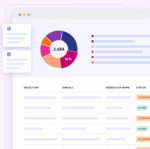
What Agile has done for software development is no short of a shift in the mindset of how apps should be built: to make the process more streamlined and efficient by emphasizing that sometimes the best way to navigate something as chaotic as software development is to lean into the chaos.
No-code platforms are also built to pump more speed and flexibility into development. The four core values of Agile have a lot in common with a no-code approach: individuals and interactions over processes and tools, working software over comprehensive documentation, customer collaboration over strict adherence to contract terms and the flexibility to respond and adapt to change as a better strategy than following a plan.
And these same themes ring true throughout a no-code philosophy.
- Innovation in the hands of people, not systems.
Agile is meant to facilitate collaboration between developers, allowing them to adapt to changing needs through interaction. Similarly, developing with no-code sees people as the core over processes and tools.
Technology should be a facilitator, not a barrier. By removing the hurdle of programming, no-code opens the developer playing field to a much wider audience than the limited population of highly-specialized programmers. One of the biggest selling points of no-code platforms is that you can use them to speed innovation by turning more of the workforce into developers.
- Working prototypes in a matter of days.
No-code platforms are not susceptible to hand-coding errors. Visual modeling is intuitive, and UI components and data service integrations make it possible to build working prototypes in just days of developing.
At this speed, it’s easy to focus on an output of working software that meets user requirements. If this is a priority of an Agile approach, then no-code has it covered hands-down.
- Empower customers to be actively involved.
Customers should be active participants to whatever extent possible so they can contribute their own knowledge. This ensures that the solution achieves what it set out to. When shipping out a development project, you are almost guaranteed not to get back exactly what you wanted in the end.
With no-code platforms, clients and users can make changes to applications themselves because of the ease of use. Incorporating an element of “DIY” to app development means happier customers and time saved by eliminating revisions.
- Enable design thinking.
Design thinking is a great tool for embracing change. Design thinking is a strategic 6-step approach to problem solving, centered on the customer and continuous ideation. One of the greatest strengths of a design thinking approach is that it is cyclical; you can revisit previous steps and make changes as you go along. This supports faster iteration and guides the path to developing the most successful app possible, maintaining a customer focus at all times, thinking simply and scaling up step-by-step.
No-code development, with cloud-based platform options and one-click deployment possibilities, supports a design thinking approach. By focusing on adaptation and continuous integration, you avoid the risk of getting locked into a plan that could lead to technical debt.
—
If your goal is agility, no-code can be a handy solution. Consider the Agile sprint. Sprints don’t always result in a billable final product–there’s a limit to what a programmer can accomplish with coding in a 2 week timeframe. Of course, there is also a limit to what one can accomplish with no-code platforms within a 2 week timeframe, but it will be an end product that is much further in production because of the time saved by not having to code by hand. In the low-code/no-code era, traditional programming might be more suited to long-distance running than sprinting.
Critics claim that no-code platforms aren’t equipped to build mission critical applications, and of course that depends on the platform and the demands of the app. But with the growth of the low and no-code markets, there are constant developments that push the boundaries of what these platforms are capable of.
If you want to create more agility and efficiency within business, a no-code platform can get the wheels oiled and turning smoothly. A no-code platform can operate compliant with IT, where IT can actually govern and monitor all activities to avoid the risk of ‘Shadow IT.’ Delegate the smaller administrative and monitoring apps clogging IT’s backlog to business developers or other roles so that IT can focus on the big hairy tasks. Even large organizations can start to operate with the agility of start-ups.






